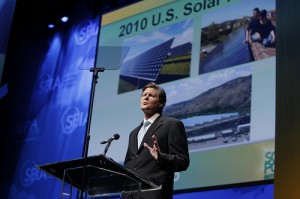 SunRun, a San Francisco based home solar company, was honored today as CEO Edward Fenster and President Lynn Jurich accepted the Business & Finance Leaders of the Year Award at the Renewable Energy World North America Conference & Expo.
SunRun, a San Francisco based home solar company, was honored today as CEO Edward Fenster and President Lynn Jurich accepted the Business & Finance Leaders of the Year Award at the Renewable Energy World North America Conference & Expo.
Since the start of 2011 SunRun has already received two industry awards, garnered national recognition for a report called “The Impact of Local Permitting on the Cost of Solar Power,” and celebrated its 10,000th customer. The company installs more than $1 million in residential solar every day to give Americans an affordable way to go solar. “Residential solar is growing rapidly and SunRun’s successful business model puts them at the head of the pack,” said Renewable Energy World publisher Oliver Strube. “They beat out hundreds of nominees in this category because SunRun’s impressive growth – 300 percent in 2010 – demonstrates they know how to transform a great concept into real results.”
With solar power service, SunRun owns, installs, repairs, and insures the solar panels, while the homeowner simply pays a monthly bill for the power they use. Typically, a homeowner will save between 10-15 percent right away on total electricity bills, plus tens of thousands over time as utility rates increase.”We’re honored to accept this award on behalf of our entire team, as Lynn and I represent just one part of the tireless effort that goes into making SunRun successful,” said Edward Fenster, SunRun CEO. “Today we bring solar to thousands of rooftops, but our goal is to power millions of American homes and we’re on track to achieve that.”
GREEN WEBINARS







